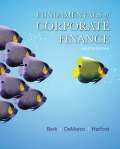
DATA CASE As a new junior analyst for a large brokerage firm, you are excited to demonstrate the skills you learned in college and prove that you are worth your attractive salary. Your first assignment is to analyze Johnson & Johnson stock. Your boss recommends determining prices based on both the discounted
l. GO to Reuters (http://www.reuters.com) and enter the for Johnson & Johnson (JNJ) in the "Search" box, then select Johnson and Johnson. From the main page for JNJ, gather the following information, and enter it into a spreadsheet:
a. The current stock price (on the left side of the page)
b. The EPS (TTM)
c. The number of shares of stock outstanding
d. The industry P/E (TTM) ratio
Want to see the full answer?
Check out a sample textbook solution
Chapter 10 Solutions
EBK FUNDAMENTALS OF CORPORATE FINANCE
- Wildcat, Incorporated, has estimated sales (in millions) for the next four quarters as follows: Q1 Q2 Q3 Sales $ 195 $ 215 $ 235 Q4 $ 265 Sales for the first quarter of the following year are projected at $210 million. Accounts receivable at the beginning of the year were $83 million. Wildcat has a 45-day collection period. Wildcat's purchases from suppliers in a quarter are equal to 50 percent of the next quarter's forecast sales, and suppliers are normally paid in 36 days. Wages, taxes, and other expenses run about 20 percent of sales. Interest and dividends are $18 million per quarter. Wildcat plans a major capital outlay in the second quarter of $98 million. Finally, the company started the year with a $84 million cash balance and wishes to maintain a $40 million minimum balance. a-1. Assume that Wildcat can borrow any needed funds on a short-term basis at a rate of 3 percent per quarter and can invest any excess funds in short-term marketable securities at a rate of 2 percent per…arrow_forwardConsider the following two bonds: Bond A Bond B Face value $1,000 $1,000 Coupon rate (annual) 8% 8% YTM 9% 7% Maturity 10 years 10 years Price (PV) ? ? Calculate the price for each bond. What is the primary factor affecting the prices of the bonds? Indicate which bond is premium and which one is discount. Is there any relationship between the YTM and the coupon rate in case of premium/discount bonds? Now, consider the following two bonds: Bond X Bond Y Face value $1,000 $1,000 Coupon rate (annual) 8% 8% YTM 11% 11% Maturity 5 years 10 years Price (PV) ? ? Calculate the price for each bond. What is the relationship between bond price and maturity, all else equal? A bond with a par value of $1,000 and a maturity of 8 years is selling for $925. If the annual coupon rate is 7%, what’s the yield on the bond? What would be the yield if the bond had semiannual payments?…arrow_forwardDon't used hand raitingarrow_forward
- Don't used Ai solutionarrow_forwardAssume an investor deposits $116,000 in a professionally managed account. One year later, the account has grown in value to $136,000 and the investor withdraws $43,000. At the end of the second year, the account value is $107,000. No other additions or withdrawals were made. During the same two years, the risk-free rate remained constant at 3.94 percent and a relevant benchmark earned 9.58 percent the first year and 6.00 percent the second. Calculate geometric average of holding period returns over two years. (You need to calculate IRR of cash flows over two years.) Round the answer to two decimals in percentage form.arrow_forwardPlease help with these questions.arrow_forward
- Please help with these questionsarrow_forwardIn 1895, the first U.S. Putting Green Championship was held. The winner's prize money was $170. In 2022, the winner's check was $3,950,000. a. What was the percentage increase per year in the winner's check over this period? Note: Do not round intermediate calculations and enter your answer as a percent rounded to 2 decimal places, e.g., 32.16. b. If the winner's prize increases at the same rate, what will it be in 2053? Note: Do not round intermediate calculations and enter your answer as a percent rounded to 2 decimal places, e.g., 32.16. a. Increase per year b. Winners prize in 2053 %arrow_forwardDerek plans to retire on his 65th birthday. However, he plans to work part-time until he turns 73.00. During these years of part-time work, he will neither make deposits to nor take withdrawals from his retirement account. Exactly one year after the day he turns 73.0 when he fully retires, he will begin to make annual withdrawals of $183,008.00 from his retirement account until he turns 94.00. After this final withdrawal, he wants $1.52 million remaining in his account. He he will make contributions to his retirement account from his 26th birthday to his 65th birthday. To reach his goal, what must the contributions be? Assume a 6.00% interest rate. Round to 2 decimal places.arrow_forward
 Principles of Accounting Volume 2AccountingISBN:9781947172609Author:OpenStaxPublisher:OpenStax College
Principles of Accounting Volume 2AccountingISBN:9781947172609Author:OpenStaxPublisher:OpenStax College Intermediate Financial Management (MindTap Course...FinanceISBN:9781337395083Author:Eugene F. Brigham, Phillip R. DavesPublisher:Cengage Learning
Intermediate Financial Management (MindTap Course...FinanceISBN:9781337395083Author:Eugene F. Brigham, Phillip R. DavesPublisher:Cengage Learning





